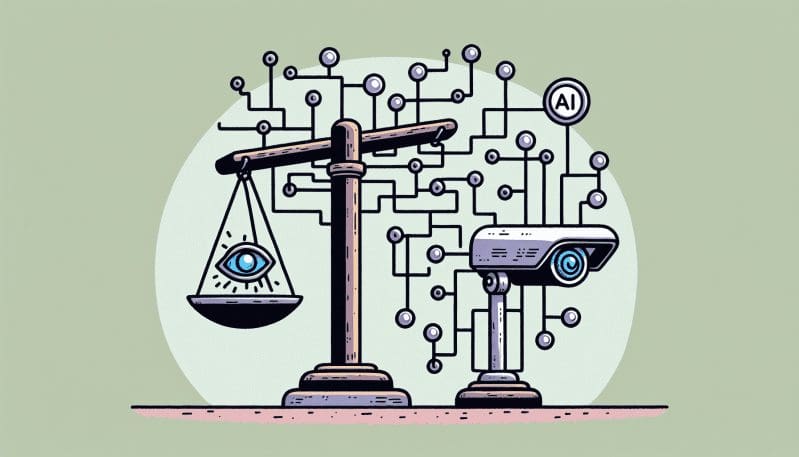AI-powered surveillance systems are transforming security by analyzing video footage in real-time to detect unusual activities and predict behaviors. These systems use deep learning algorithms to identify issues like loitering, unauthorized access, and even abandoned objects, sending alerts instantly. However, they also bring considerable privacy concerns. Balancing safety and privacy is critical. Developers can use strategies like data minimization, consent management, and privacy-by-design principles to tackle these challenges. Technologies such as federated learning and differential privacy can boost privacy protection. Furthermore, regular audits and user feedback help reduce bias and improve fairness. Updating systems to comply with regulations like GDPR is essential. There’s more to know about integrating these enhancements effectively.
Key Takeaways
- Enhanced threat detection improves security but raises concerns about surveillance overreach.
- Algorithmic bias and data privacy risks must be actively addressed to ensure fairness.
- Privacy-by-design and minimizing data collection can help protect individual rights.
- Transparent algorithms and regular audits are crucial for accountability and accuracy.
- Compliance with regulations like GDPR is vital for balancing AI benefits and privacy.
The New Era Of Intelligent Security Systems
As technology advances, the way security systems operate is changing dramatically.
We’re in the age of AI-powered surveillance, where cameras don’t just record—they understand. These intelligent systems use deep learning algorithms to detect unusual activities, like someone loitering or a car parked in a no-parking zone. They can even discern faces and license plates, making it easier to track and find specific people or vehicles. For example, integrating object recognition can automate tasks such as detecting abandoned objects or unauthorized access in real-time.
But how does it work? The software analyzes video footage in real-time, using data it’s learned from thousands of examples. For instance, it knows that someone jumping a fence isn’t normal and alerts security instantly.
This isn’t just about better cameras; it’s about smarter software. Developers are using neural networks and machine learning to improve these systems daily.
Imagine a world where security isn’t just about watching, but understanding and reacting—that’s the new era of intelligent security systems.
Current State Of AI Surveillance Technology
Today’s AI security systems can identify faces, track movements, and even predict behaviors, all in real-time.
These abilities are being used across industries, from spotting shoplifters in retail to ensuring safety in public spaces.
However, these systems still face hurdles like bias in facial identification and struggles with crowded or poorly lit environments.
What’s Technically Possible With Modern AI Security Systems
When one considers the capabilities of modern AI security systems, it’s clear that technology has come a long way.
Today’s systems can detect and track individuals across multiple cameras, thanks to advanced object detection and tracking algorithms. They can even identify specific people using facial recognition, or recognize unusual behavior patterns that might indicate a problem.
Real-time analytics are now common, with systems able to process video feeds instantly to alert authorities of potential issues. Furthermore, these systems can learn and improve over time with machine learning, enhancing their accuracy and effectiveness.
Some advanced systems can also integrate various sensors and data points, like thermal imaging or audio detection, to provide a thorough security solution. In addition, they can operate in diverse environments, modifying to different lighting and weather conditions.
Real-World Applications Across Industries
Modern AI surveillance technology has evolved considerably, with real-time analytics and advanced object detection transforming what’s possible. Across various industries, these tools aren’t just enhancing security but also improving operations and efficiencies. AI isn’t only about identifying suspicious activities—it’s about analyzing patterns, predicting behaviors, and even automating routine tasks.
- Retail: Stores use AI to monitor inventory levels and identify potential theft. Cameras can track customer behavior to optimize store layouts and improve shopping experiences.
- Transportation: AI systems in airports and train stations help manage crowd flow, monitor security checkpoints, and detect anomalies like unattended bags.
- Healthcare: Hospitals use AI to guarantee patient safety by monitoring areas where equipment or patients need constant observation, without needing human eyes there 24/7.
- Urban Planning: Smart city initiatives utilize AI cameras to manage traffic, monitor public spaces, and even detect environmental changes like air quality shifts. The innovative use of video surveillance as a service (VSaaS) has also been a game-changer in smart city projects.
These applications don’t just boost security—they make operations smoother and more efficient, offering crucial perspectives for better management decisions.
Key Limitations And Common Implementation Failures
Despite the remarkable progress made in AI-powered surveillance, numerous challenges hinder its flawless implementation. One key limitation is data quality. If the data fed into the AI isn’t accurate or diverse enough, the system might misinterpret situations or fail to identify specific behaviors. This is known as “garbage in, garbage out.”
Furthermore, AI models can struggle with real-time processing, especially in crowded or complex environments. The sheer volume of data can overwhelm the system, causing delays or inaccuracies.
Another common failure is the lack of flexibility. AI systems often rely on predefined rules and patterns, making it hard for them to handle unexpected situations. For instance, sudden changes in weather or lighting can confuse the AI, leading to false alarms or missed threats.
Integration issues also plague AI surveillance. It isn’t easy to combine new AI technologies with older security systems, which can create gaps in coverage and functionality.
Privacy concerns are a major implementation barrier. People worry about being constantly watched and having their personal data misused or stolen. Ensuring data protection and privacy often requires complex regulations and compliance measures, which can be difficult and costly to implement.
AI Surveillance Benefits Versus Cybersecurity And Privacy Risks
AI-powered surveillance boosts threat detection and operational efficiency by quickly analyzing vast amounts of data.
However, it also raises concerns about data privacy and potential surveillance overreach.
Furthermore, AI ethics come into play, particularly in addressing algorithmic bias and accuracy issues which can impact end-users considerably.
Enhanced Threat Detection And Operational Efficiency
Cutting-edge surveillance systems now use artificial intelligence (AI) to boost threat detection and streamline operations. These systems can identify unusual behaviors or items in real-time, making them more effective than traditional methods.
AI surveillance doesn’t just improve security; it also makes operations more efficient. Operators don’t have to watch every camera feed constantly. Instead, the AI can alert them when something needs attention, allowing them to focus on other tasks.
- AI can quickly analyze vast amounts of video footage, much more than a human ever could.
- These systems never get tired or distracted, providing constant vigilance.
- AI can learn and improve over time, adjusting to new threats and patterns.
- Beyond security, AI can also help with operational tasks, like monitoring crowds for better management.
Data Privacy Risks And Surveillance Overreach Concerns
While AI-enhanced surveillance systems offer substantial benefits in threat detection and operational efficiency, they also raise important questions about data privacy and the potential for surveillance overreach. The use of AI means tons of data is collected and analyzed. This data can include personal details like faces, license plates, and daily routines. If not properly secured, this information could be stolen or misused. Furthermore, there’s a risk of surveillance overreach, where data is used beyond its original purpose, infringing on individuals’ privacy. Companies can start managing potential data breaches to simplify clients’ lives.
| Benefits of AI Surveillance | Privacy Risks | |
|---|---|---|
| 1 | Real-time threat detection | Data breaches |
| 2 | Improved operational efficiency | Surveillance overreach |
| 3 | Automated alerts | Lack of consent |
| 4 | Pattern recognition | Discrimination |
| 5 | Predictive analytics | Transparency issues |
To make matters even more complex, laws and regulations are still catching up to AI technology. Some places have strict rules, while others have none at all. Developers are exploring ways to balance the benefits of AI surveillance with privacy protection. Techniques like data anonymization, differential privacy, and federated learning are gaining traction. These methods aim to safeguard individual privacy while still providing useful data analysis. Moreover, developers are incorporating more user-consent options and transparent data practices into their systems.
AI Ethics: Addressing Algorithmic Bias And Accuracy Issues
Although AI-enhanced surveillance systems provide substantial advantages, they also present ethical challenges that developers must consider. One important issue is algorithmic bias, where the AI might unfairly target specific groups based on flawed data.
Moreover, accuracy issues can lead to false positives or negatives, potentially causing serious problems for innocent people.
- Data Diversity: Ensuring the training data includes a wide range of scenarios and demographics can help reduce bias.
- Regular Audits: Conducting regular audits of the AI system can help identify and correct biases and inaccuracies over time.
- Transparent Algorithms: Using transparent algorithms allows for easier scrutiny and understanding of how the system makes decisions.
- User Feedback: Incorporating user feedback can help continuously improve the system’s fairness and accuracy.
Developers can work on improving data collection methods and refining algorithms to address these concerns.
Balancing the benefits of AI surveillance with ethical considerations is vital for creating trustworthy and effective systems.
Best Practices For Implementing Privacy-Respecting AI Surveillance
Implementing privacy-respecting AI surveillance involves several key technologies and strategies.
Experts often talk about using security solutions like encryption methods to protect data.
Two main approaches are discussed frequently: privacy-by-design, where privacy is considered from the start, and data protection strategies that focus on minimizing data collection.
Compliance frameworks and regulatory requirements, such as GDPR, are also essential for ensuring these systems respect user privacy.
Recommended Technologies And Security Tech Solutions
As AI surveillance becomes more prevalent, selecting the right technologies and security solutions is essential for safeguarding privacy. Several technologies and solutions can help enhance privacy in AI surveillance systems.
- End-to-End Encryption: This guarantees that data is encrypted from the moment it’s captured until it’s viewed by an authorized person. This means even if data is intercepted, it can’t be understood without the decryption key.
- Differential Privacy: This adds noise or randomness to data to protect individual data points while maintaining the overall accuracy of the dataset. It’s like pixelating a small part of an image to protect details while keeping the big picture clear.
- Federated Learning: This allows AI models to be trained on decentralized data without exchanging it. Imagine teaching a robot to identify cats by showing it pictures from many phones, but never actually seeing the pictures yourself.
- Secure Multi-Party Computation (SMC): This allows different parties to compute a function together without revealing their inputs to each other. It’s like calculating the average salary of a group without anyone knowing anyone else’s salary.
These technologies can help maintain privacy in AI surveillance.
Privacy-By-Design Approaches And Data Protection Strategies
While AI surveillance systems are becoming more common, there’s a growing need to confirm they’re designed with privacy in mind right from the outset. This approach is known as Privacy-by-Design. It means that when developers create these systems, they must think about how to protect people’s personal data from the very beginning, not as an afterthought.
Some key strategies include data minimization, which means only collecting and storing data that’s absolutely necessary. For example, instead of constantly recording and saving video footage, the system could only start recording when it detects something unusual.
Another strategy is data anonymization. This is where the system automatically blurs or hides faces and other identifying features. That way, even if the data gets stolen, it can’t be used to identify people.
Furthermore, implementing strong encryption helps guarantee that even if the data is intercepted, it can’t be read without the right keys.
Finally, systems can be designed to limit data access. Only authorized individuals should be able to view or manage the surveillance data.
Compliance Frameworks And Regulatory Requirements
Globally, numerous regions have established compliance frameworks and regulatory requirements to govern AI surveillance. These rules make sure that AI is used fairly and doesn’t harm people’s privacy.
Different places have different laws, but they all want to make sure that AI surveillance is used safely and responsibly.
Here’s what some of these frameworks include:
- Data Minimization: This means only collecting the data that’s really needed. If an AI system doesn’t need specific info, it shouldn’t ask for it.
- Consent Management: People should know when they’re being watched by AI. They should also be able to say “yes” or “no” to it.
- Transparency: It’s important to be clear about how AI surveillance works. This means telling people what data is being collected and how it’s being used.
- Accountability: There should be clear rules about who’s responsible if something goes wrong. This helps make sure that issues are fixed quickly and fairly.
Frequently Asked Questions
How Much Does AI Surveillance Cost?
The cost of AI surveillance can vary greatly depending on the scale and intricacy of the system. Small installations may start at a few thousand dollars, while large, citywide networks can cost millions. Additional expenses come from maintenance and data management. Hardware costs, such as cameras and servers, also contribute considerably.
Who Are the Major Providers of AI Surveillance?
Major providers of AI surveillance include companies such as IBM, NVIDIA, and Cisco. Furthermore, startups like AnyVision, SenseTime, and Megvii are prominent players in this market. Governments and institutions also develop proprietary AI surveillance systems.
Can AI Surveillance Be Used in Private Homes?
Yes, AI surveillance can be used in private homes. Individuals may install smart security cameras and other IoT devices equipped with AI capabilities for monitoring and automation purposes. These systems can detect unusual activities, identify faces, and send real-time alerts to homeowners. However, this raises concerns about data security and privacy, as sensitive information may be collected and stored. It is essential for homeowners to understand the potential risks and choose systems from reputable providers with strong privacy policies.
How Does AI Surveillance Affect Low-Income Communities?
AI surveillance in low-income communities often leads to over-policing and disproportionate surveillance. It can exacerbate existing inequalities, with residents experiencing higher rates of false positives and increased privacy invasions. Limited access to legal resources compounds these issues, creating a disparate impact on these communities.
What Is the Public Perception of AI Surveillance?
Perceptions of AI surveillance vary greatly. Some individuals appreciate the potential security benefits, while others express concerns over privacy invasions. Many harbor fears about constant monitoring, profiling, and data misuse.
Conclusion
AI-powered surveillance is getting smarter, with cameras now able to identify faces and spot unusual activities. However, this tech raises concerns about privacy and data security. It’s possible to make these systems more privacy-friendly by focusing on developing features that minimize data storage and use AI processing locally on devices. Furthermore, giving users clear controls over when and how surveillance is used can help. Developers are exploring ways to encrypt data and use anonymous info for improving systems without invading privacy. Future improvements rely on continuous balancing of safety benefits and privacy protection.







